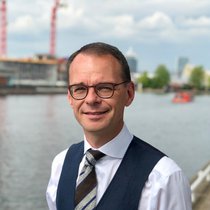Both public and commercial use of urban canals is changing. In-depth interviews with water managers and spatial planners revealed that demand for many uses will likely increase by 2040. This increasing demand is most certain for transportation, thermal energy extraction, and recreation. Emerging new uses include local climate regulation and reuse of waste products. With these increasing use ambitions, the question arises how suitable the canals are for important human use functions. The assessment framework is applied for canals and canalized rivers in two European delta cities: Amsterdam and Ghent.

Example of the output of the Suitability Index (SI) assessments for Thermal energy extraction (a), Transport (b) and Recreation (c) in Amsterdam.
Transport
City councils increasingly wish to expand waterborne transport as response to road congestion and ambitions to reduce greenhouse gas emissions from trucks. The European Commission also proposes better utilization of urban waterways for the first and last mile in the Trans-European Transport network that is being developed until 2050. Examples of goods that are already transported by ships are construction materials and urban waste (Figure 2).

Transport of waste (left) and construction materials (right) in Amsterdam. Pictures by Suzanne van der Meulen (left) and Marc Brink (right)
Thermal energy extraction
Demand for thermal energy extraction from urban canals is increasing due to the ambition to reduce fossil fuel use for heating and cooling. Development areas close to water provide good opportunities to link demand and supply of aquathermal energy. We developed a Suitability Index for thermal energy extraction to assess the suitability of urban surface water for heating of buildings, based on the heat exchange potential of the water.
New residential areas use thermal energy from surface water for heating or cooling. Picture by Suzanne van der Meulen
Suitability scores of the canal systems in Amsterdam and Ghent for thermal energy extraction are fair to excellent. This shows that even relatively small urban waterways can play a role in the energy transition. The suitability for thermal energy extraction can be improved by increasing either width of the canal or discharge (the volume of waterflow per time unit). Since the required increase of width is quite large and space in scarce in a city, increasing the water flow may be a more feasible solution.
Recreation
Urban water recreation is mainly increasing due to population growth and transformation of former industrial (harbor) areas into residential areas and cultural hotspots. Demand is also pushed by climate change (higher temperatures) and the popularity of outdoor sports. The suitability for swimming at the assessed sites in Amsterdam and Ghent, based on health risks, are low.
“A notable development is the increasing popularity of swimming in urban surface water, even though most waters are not officially designated bathing waters”
Suzanne van der Meulen - PhD Candidate at Wageningen University & Research


Low clarity can hide submerged dangers such as obstacles under water. Pictures by Suzanne van der Meulen (left) and Floris Boogaard (right)
Recommendations
To deal with changing and increasing demands, we advise water managers to proactively manage functional quality and the use of urban surface waters. This could prevent undesirable situations due to conflicting uses and surface water bodies not being fit for purpose. Our assessment framework for functional quality of urban surface water enables assessment of the suitability of urban waters for different use functions in a consistent and transparent way. Assessment results can support prioritization of conflicting water uses and guide investment decisions to improve functional quality of urban surface water. As such, our framework can provide a common knowledge base for water managers and spatial planners. This research showed that many human use functions of urban surface water involve in-situ uses rather than water extractions. This means that increasing demand likely results in competition for space between water users.
Future research is needed to further develop our assessment framework for functional quality of urban surface water. The generic protocol for Suitability Index development can be used to develop SIs for more use functions and for more urban contexts. To support sustainable multifunctional use of water, research on trade-offs between human use functions and amongst human use functions and ecological ambitions is recommended.
For more information
This study is part of the Urban Pulse II program of AMS Institute. The information in this online article is based on the PhD thesis ‘Functional quality of urban surface water’ by Suzanne van der Meulen. This thesis includes more detailed recommendations for water managers and for future research.
